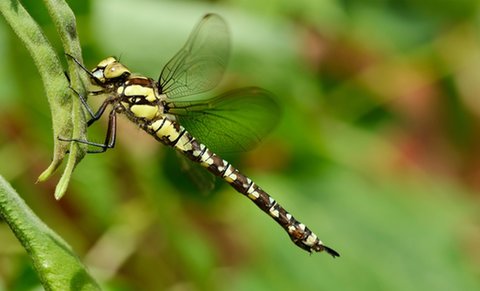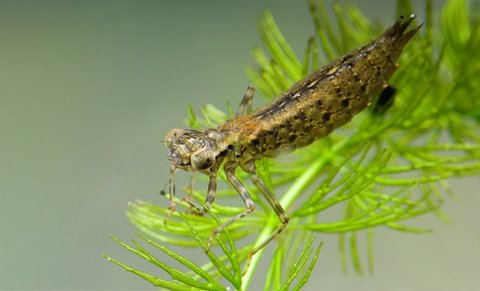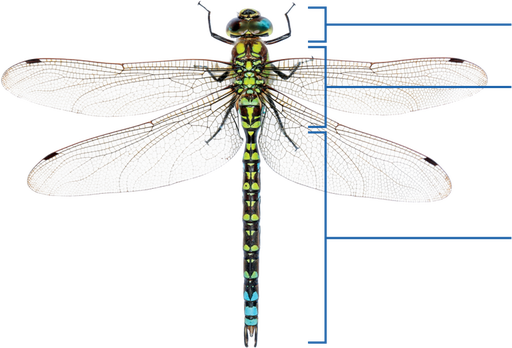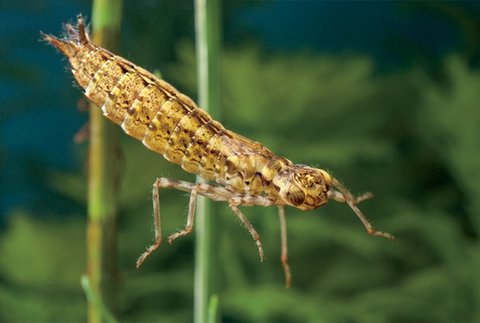
adultdragonfly
Theolderversionhasthreebodysegments,likeallinsects:thehead,thorax,andabdomen.Ithassixlegs.Ithastwopairsofwings.Itshuge,complexeyesaresoclosetogetheronthetopofitshead,theytouch.Thecolorsofitsbodyare brilliant.

dragonflynymph
Theyoungerversionalsohasthreebodysegments.Ithassixlegs,too.However,itswingshavenotyetformed.Itseyesaresetfarapart.It’snotas colorful.
Thisisthesameanimal—thesouthernhawkerdragonfly.You arejustseeingitatdifferentpointsofits life.
Ifyoulookatthemside-by-side,youmightnotknowtheyaredifferentversionsofthesame thing.

InsectBody Parts
head
thorax
abdomen
ChangesAhead
Allinsectsundergometamorphosisaspartoftheirlifecycles.Thisisaprocessofchangethattakesplaceasaninsectapproachesadulthood.Morethan
80percentofinsectsexperiencewhatisknownasacompletemetamorphosis.Theirbodiesmovethroughfourstages:egg,larva,pupa,andadult.Dragonfliesexperienceincompletemetamorphosis.Theirbodiesonlygothroughthreestages:egg,nymph, andadult.Dragonfliesskipthepupastage—whenmanyinsectsencasethemselvesinachrysalisor cocoon.
SouthernhawkersareoneofthemostcommonandwidespreaddragonfliesinEurope.Theylivenearsmallpondsandopenwoodland.Eachdragonflybeginslifeasan egg.
Afteramaleandfemalemateinlatesummerorearlyfall,thefemalelayshereggsinsidethestemsorleavesofawaterplanttokeepthemsafefrompredators.Shelayshereggsoneata time.
Tohatchinthespring,theyoungdragonflyswallowswaterthatitdrawsthroughtinyholesinthecasingoftheegg.Thatcausestheeggtoswell.Theyoungdragonflyhasasharppointeronitshead,whichitusestobursttheegg open.
Whatemergesiscalledaprolarva.Itiscoveredbyathinmembrane.Assoonasitfreesitselffromthemembraneandentersthewater,it molts, orshedsitsskin.Itisnowa nymph.
Nymphsmustmoltanumberoftimesastheygrow.That’sbecausetheirouterlayer,calledanexoskeleton,cannotstretchorgrow.Whentheinsectgetstoobigforitsskin,theskinsplits open.

Asouthernhawkernymph'sbodyisbrownandgreen.Thesecolorsmakethenymphhardertoseeinthe water.
Asouthernhawkernymphmoves underwater.
Thenymph’smusclescontract.Ittakesdeepbreathsthatcausethesplitinitsoldskintowiden.Whenthetearisbigenough,thesouthernhawkershrugsoutoftheoldskin.It’sliketakingoffasweater.Nowthedragonflynymphisslightly larger.
Moltingishelpfulinanotherway.Itallowsdamagedtissuetohealandmissinglimbstoregenerate,orgrowagain.Yet,moltingcanbeadangeroustimeforthesouthernhawker.Duringtheprocess,thisinsectcannotmove.Itsnewskinissoft.Untilthenewexoskeletonhardens,thenymphisvulnerableto predators.
MoreMobile
Adragonflynymphcanzipthroughthewater.Believeitornot,itmovesbysquirtingwateroutofitsbackend.Thispropelsitforward.Theserapidburstsofspeedcauseitssleek,torpedo-shapedbodytoglide.Itneedstomovequickly,becauseitisanactive hunter.
Thenymph’sbodyisbrownandgreen.Thesecolorshelpitblendinwithpondorlakewater.Itisdifficultforbothpredatorsandpreytospotit.Yet,thenymphcanseethemquite well.
Atthisstageinitslife,thesouthernhawker’slargeeyesaresetfarapart.Theyarespecializedtodetectmovement.Thoseeyesareconstantlyscanningfor prey.
Thenymphneedstoeatconstantly.Whatitislookingforisaquaticinsects,smalltadpoles,invertebrates,andeven
small fish.
Asouthernhawkernymph'seyesaresetfar apart.

